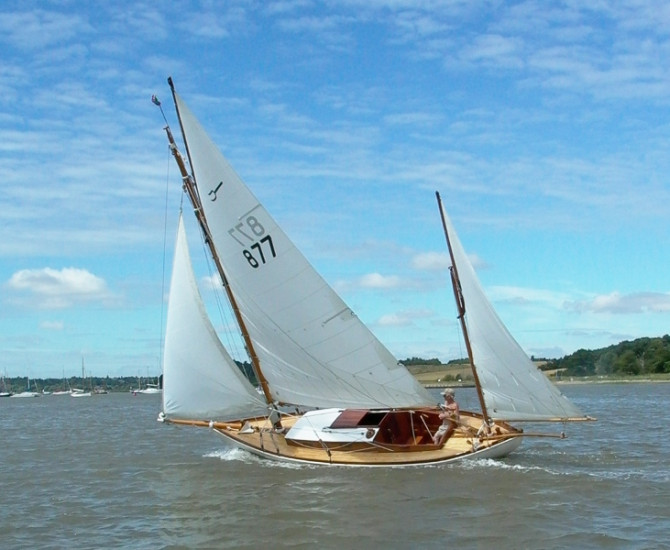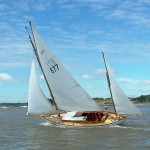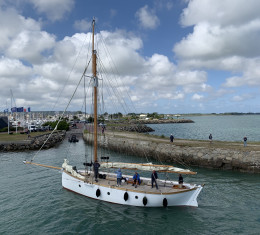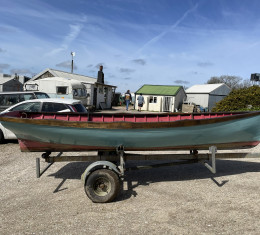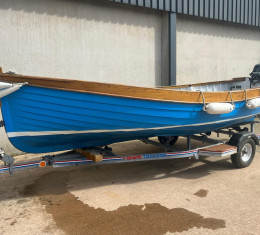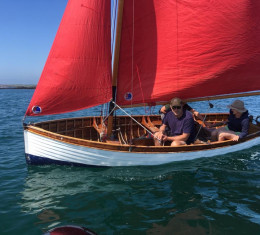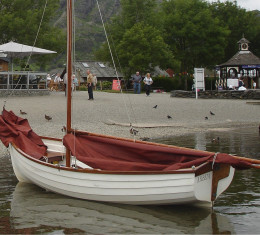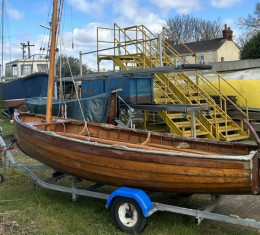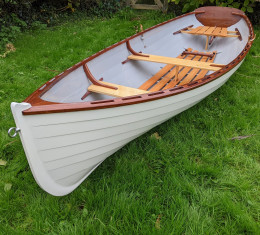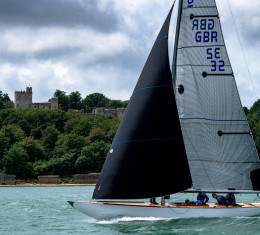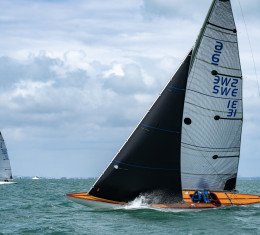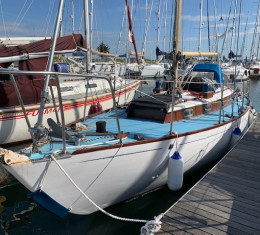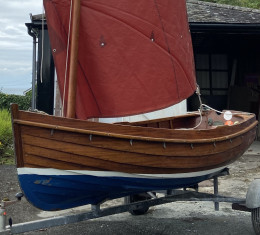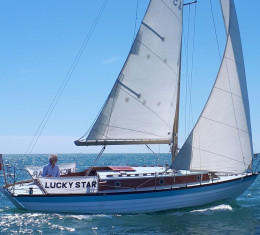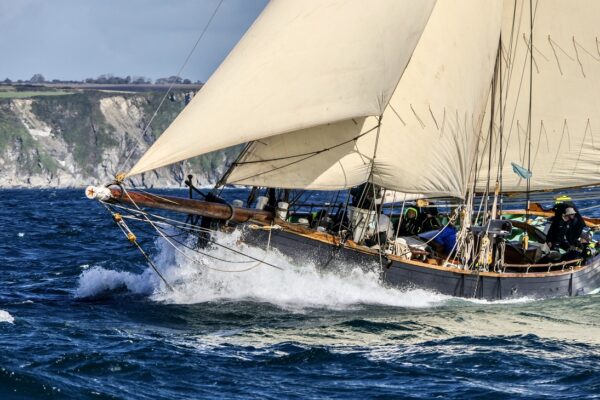Sailing yachts
Full specification
Wooden ships comments on this Albert Strange Yawl
Albert Strange is one of the great names in yacht design, one of that band of gifted amateurs whose names dominate the era of classic yachting – Claud Worth, Harrison Butler, George Holmes et al.
Amongst other skills, Strange was a gifted artist whose paintings now sell for high prices.
His yachting interest started with sailing canoes, a fashion in sailing made popular by barrister John Macgregor in his sailing canoe Rob Roy in the 1890’s.
Strange was an enthusiast for the small boat sailor at a time when yachting was by and large the reserve of the wealthy and his early designs were for this type of craft which we call the canoe yawl – small, engineless sailing yachts of relatively shoal draft, sometimes with centre-boards and with a pointed canoe-counter stern, a feature which Strange took to ultimate perfection.
The lines of the stern of a yacht are more important than the bow. The stern must allow the water to run away freely with minimum drag but also provide the buoyancy required to sustain the crew in the cock-pit and lift her to a following sea.
Shelia was his first deep keel design commission, drawn for fellow artist Robert Groves who sailed her in the waters of the Scottish West Coast and the Hebrides in the early days of the century at a time when sailing such voyages in a small yacht was considered impossible. Named for Groves’ eldest daughter, she is the oldest known surviving Strange yacht.
This little Albert Strange yawl is one of the more remarkable examples of our English yachting heritage and one of the finest small vintage yachts afloat. She represents the very start of small yacht cruising, a true classic of yacht design and an inspiration to designers and sailors for many years to come. Over 100 years later she survives very much the same as when first built and sailing now exactly as she did for her first owner.
In exceptional condition, she is looking for a new guardian conscious of her pedigree and ability and capable of ensuring her continued survival for another century.
Built in 1905 by Robert Cain, boat builder in Port St Mary IoM her first home port was in Tarbert on Scotland’s West Coast.
25’ x 19’6”wl x 6’9” x 3’5” + bowsprit and bumpkin. 4TM
Already a well-known yacht for her documented voyages she was damaged in a storm in Dublin Bay in 1914, written off by the insurers, sold to and rebuilt by Capt. Patrick Walsh of Dublin who added 5’ to the keel depth and fitted a rather exotic kauri pine swept deck.
He sold her in 1920 to buy Groves’ next yacht, Sheila 11.
Sheila has a varied and mostly recorded history including being damaged by a bomb in a Scottish boat-yard in 1939.
The yacht has an extensive archive including some items from her original owner and a set of original line drawings.
Present ownership since 1978 followed by an extensive, largely professional restoration.
The deck was removed and the hull stripped of all paint inside and out.
The keel bolts replaced.
All hanging and lodging knees replaced
Several deck beams replaced in Honduras mahogany.
The interior rebuilt in the spirit of the original design with the help of Groves’ original drawings.
The rig rebuilt.
Humber Yawl Club cruising trophies 1910, 1911 and 1983.
Trophies from the Cruising Association, Woodbridge Cruising Club and OGA for her Deben to Douarnenez cruise in 1988 and some 30 trophies from the OGA
Construction.
Planked in full length ¾” Pensacola pitch-pine fastened with copper nails and roves to grown oak frames at 3’ centres with 2 steam bent intermediate timbers all on a very substantial oak back-bone.
Long external iron ballast keel secured with EN58J anaerobic stainless steel keel bolts in 1978.
Keel bolts drawn 2009 and found in perfect condition.
Garboards replaced in iroko in 1985
New mast step 2008 – a massive piece of iroko.
Original built rudder trunking modified by sleeving with a 3mm wall hard copper pipe and has proved to be totally water-tight for the last 35 years.
A substantial athwartships oak beam forms a bridge deck between cock-pit and cabin and strengthens the mid-ships hull.
Deck.
The original straight-laid pine deck was replaced in the 1914 refit by a classic canoe yawl swept deck and faithfully copied in 1994 when a new deck was laid in Alaskan yellow cedar, secret fastened to the deck beams, swept and joggled to varnished teak king plank between varnished teak cover-boards and toe rails.
The underside of the deck is beaded on the plank edges.
The seams are payed in a specialist butyl rubber compound which has proved to be 100% water-tight.
Cabin and cock-pit coamings in varnished teak are original.
Bronze rudder stock head and ring inscribed with the yacht’s name, date and builder.
Bronze deck fittings.
Rig
Gaff yawl rig setting 330sq’ sail.
Original Norway spruce main mast stepped through the deck onto the new mast step.
The mizzen mast and all the other spars all date from various times in the present ownership, all in varnished spruce to the original rig design.
In present ownership, new cranse iron; new mast head bands x 3; new gammon iron with twin chain rollers bolted through the stem; all custom made in galvanised steel.
Substantial bowsprit extended by 6” over original sail plan can be relatively easily unshipped for marina berthing.
Boom goose neck fitting custom made in present ownership in aluminium bronze with 8 belay pins round it and normally enclosed with a canvas mast coat to prevent sheets catching on the pins.
Slab reefing main boom sheeted to the original bronze horse on the aft deck. Patent “ luff and clew-line” reefing assures quick and simple sail reduction.
Main peak and throat halyards led aft to cleats on the coach-roof, accessed from the cock-pit.
Topping lift on a 3-part tackle also to the cleats.
Mizzen sheets to the port off-set bumpkin, rigged to brail up against the mast giving immediate sail reduction.
Mizzen mast fittings all in aluminium bronze with the same reefing system as the mainsail.
Mizzen gaff on a sliding wire span allows the sail to stand up vertically against the mast as in a gunter rig.
Laminated wooden jaws to both gaffs with parrell balls.
Stainless steel standing rigging, all new since 2004 with Talurit terminals top and bottom. Top ends shackled to the mast bands.
Lower ends made up to the bronze chain plates with lanyards as originally rigged.
2 shrouds per side to the pole main mast.
Chain plates extend down over 5 planks effectively spreading the rig loads over the hull.
Runners are a recent addition set up on tackles to accommodate the extra sail area carried when racing turned up to cleats on the cock-pit coamings.
Jib sheets pass through the cock-pit coamings and sheeted to cleats on the inside.
Sails
Cruising sails
Mainsail 150sq’ in terylene, mitre cut by Gayle Heard Sails, 25 years old and in excellent condition. Sheeted to a horse on the aft deck.
Mizzen 75sq’ is 20% of the sail area allowing the yacht to sail and tack well under mizzen and headsail. Sheeted to the bumpkin.
Jib 85sq’. 2 reefs on original wooden pole roller system – early example as our modern aluminium roller furling gear. The jib overlaps the shrouds and sheets back to the cock-pit.
Racing Sails.
Topsail 35sq’ set on a club.
Reacher Set to the end of the bowsprit and sheeted to the boom end.
Spinnaker 200sq’ Single luff set masthead to stem-head with a 20’ pole.
Mizzen staysail
The pole is in 2 parts, 8’ wooden pole with jaws to set round the mast used to pole out the jib and a 12’ aluminium extension sleeved over the wooden pole for use with the spinnaker.
No winches.
No engine or electrics. Oil lamps are carried for the cabin lighting.
Accommodation. 2 berths with infill to make one very large family berth.
When purchased in 1978, all internal joinery had been removed. With the help of Groves’ pictures the owner was able to recreate something close to the original interior joinery with 2 settee berths and a galley shelf all built in pre-war Burma teak.
The 2 settee berths run up forward. A cleat each side supports a removable insert board which converts the 2 bunks to one large bunk which allowed the owner to cruise with wife and 2 small children through the 1980’s.
Black bucket for a toilet.
Taylors 2 burner and oven paraffin cooker against the after bulkhead port side with a wet locker opposite to stbd.
An ornate saloon table with delicately inlaid marquetry work detailing her history is a recent gift to the yacht by the owner.
Water. 20 galls in 2 flexible tanks under the berths. Hand pump to a faucet by the cooker.
Stowage trays over the water tanks under the berths for clothing.
Food stowage at the bunk heads and under the bridge deck.
Fender, fisherman anchor and warp stowed under the cock-pit sole.
Chain locker forward by the mast, the warp and chain fed through a deck hawes.
The inside face of the hull has a ceiling in the same timber as the deck, easily removed for cleaning.
Inventory.
Compass
8-day clock
Vintage aneroid barometer
20lb Fisherman kedge anchor with 100’ warp
Bower anchor with 50’ 5/16” chain spliced to 90’ multiplait.
Cable up the mast for a former tri-colour nav light ready to accept a new light fitting.
Mooring warps and fenders
Walker Bay 8’ dinghy with sailing rig towed astern
Bombard AX1 inflatable dinghy stows in the stern locker
2.5hp Mariner outboard engine stows in the stern locker
Petrol and paraffin cans with some spares stow under the cock-pit seat.
Tool box stows under the cabin table.
Disclaimer:
These particulars have been prepared in good faith from information provided by the Vendors and are intended as a guide, Wooden Ships cannot guarantee or warrant the accuracy of this information nor warrant the condition of the vessel. The Purchaser should instruct his agent or surveyor to validate all details as necessary and satisfy himself with the condition of the vessel and its equipment.
Wooden Ships classic yachts brokers have an extensive database of boats for sale. With a wide range of sailboats, classic yachts, motor yachts and small classic boats, Wooden Ships has one of the largest selections of traditional wooden boats and yachts for sale in the UK.
Disclaimer:
These particulars have been prepared in good faith from information provided by the Vendors and are intended as a guide, Wooden Ships cannot guarantee or warrant the accuracy of this information nor warrant the condition of the vessel. The Purchaser should instruct his agent or surveyor to validate all details as necessary and satisfy himself with the condition of the vessel and its equipment.

